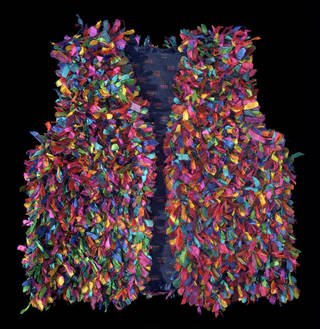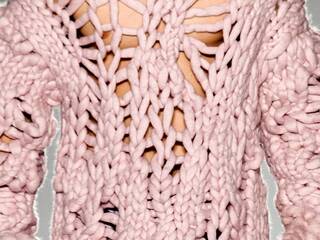With careers in knitting spanning from the 1970s to today, Patricia Roberts, Sasha Kagan, John Allen and Freddie Robins have all pushed the boundaries of knitting, as well as inspired countless people to pick up knitting needles. Speaking to the V&A, these four practitioners discuss their varying experiences, influences and future ambitions.
Patricia Roberts, knit designer
Following her BA in fashion, Patricia Roberts worked as an editor for various knitting magazines before becoming a freelance designer in 1971. Her collection of hand-knits were sold in Browns of London and Bloomingdale's in the United States and were notable for their fresh use of colour and texture, with motifs ranging from bunches of grapes and cherries to novelties such as children's sweets. Her first shop in London's Knightsbridge opened in 1976 and she went on to sell her own yarns and publish a series of influential books. Awards include the Duke of Edinburgh's Designer's prize and Design Council award, both in 1986.

What influence do you think you’ve had on knitting in Britain?
I’m considered the first British designer to elevate hand-knitting to the realms of high fashion. The early Patricia Roberts books inspired many of the UK hand-knitters of the early 1980s to take up their needles, including Kaffe Fassett. He told me how that seeing a young girl on a train knitting the 'Grapes and Cherries' sweater from one of my early books inspired him to design his own knitwear
What inspires your designs?
I believe in form and function. I don't consider what I am going to knit, but rather how I am going to knit it. I create subtle, sometimes complicated patterns, often including three-dimensional stitches, but always using exciting colours and paying great attention to the shape of the garment. Inspiration comes from anything and everything – an old cake tin from a flea market, nature, or even just from designing. The more you invent stitches, the more eloquent you become and the further you can push them. I always use natural fibre yarns. It was the dearth of their availability in the 1970s that led to launching our own brand of hand-knitting yarns in fashion colours.

Sasha Kagan, knit and crochet designer
Sasha Kagan has been described as 'the doyenne of hand-knitting' and 'the William Morris of Wales'. She studied at Exeter College of Art and the Royal College of Art, London (RCA). Taught to knit by her mother, she set up Sasha Kagan Knitwear when she moved to Wales in 1972. At the peak of her company's popularity, she employed 150 hand-knitters around the UK. Her books, including The Sasha Kagan Sweater Book (1984) and Sasha Kagan's Big and Little Sweaters (1988), contributed to the 1980s revival of hand-knitting.

What inspires and influences your designs?
My experience in textiles was learned from my mother, while my colour sense and sensitivity to design was sharpened by my art school training. Living in the depths of the Welsh countryside, I'm inspired by nature, the changing seasons, the flowers, trees and plants that I live among.
What types of materials do you prefer to use?
I like to use natural fibres: wool, cotton, silk, mohair and blends of those qualities.
What would you most like to knit that you haven't so far?
A huge patchwork hanging with all my nature-inspired motifs in one textile piece.

John Allen, knitting designer
John Allen has been a textile designer specialising in printed, woven and knitted fabrics for over 25 years. He trained at Camberwell School of Art, London, followed by the Royal College of Art, London (RCA). Instrumental in establishing the knitting department at the RCA, Allen works as a consultant designer for a diverse range of companies and has collaborated with Jonathan Anderson, Creative Director of Loewe, on a range of bags, beach towels and scarves. He has written five books of which his first, The Machine Knitting book (1985), sold over 110,000 copies.

What inspires and influences your designs?
I'm influenced by anything and everything around me, particularly patterns created by unusual light and angles. I have worked from visual inspiration as diverse as architecture, landscape, foreign cultures and rock crystals.
What types of materials do you prefer to use?
I like working with materials not normally associated with knitting, such as bubble wrap, wire and plaster, but the most amazing yarn is wool, as you can change and alter its nature by washing, heat and burning.
What would you most like to knit that you haven't made so far?
I'd like to have the time and money to knit a huge tapestry. The design would be a great challenge, as would be the technical requirements.

Freddie Robins, textile artist
Freddie Robins' practice crosses the boundaries of art, design and craft. She studied Constructed Textiles at Middlesex University (formerly Middlesex Polytechnic) and the Royal College of Art, London (RCA). At both institutions, she specialised in knitted textiles and studied under John Allen. Currently Senior Tutor and Reader in Textiles at the RCA, she is known for her subversive creations, which often tackle dark themes in a humorous way.

How would you describe your position within the knitting world?
I would like to be thought of as the anarchic knitter, the knitter who deals with issues, as opposed to fashion or function.
What inspires and influences your designs?
A weird and wide range of things. A short list: wool, women's work and feminism, traditional knitting, taxidermy, fear, my childhood and family, the human body, the anatomical preparations of Dr Frederick Ruysch, crime and murder, the Pitt Rivers Museum in Oxford, word and number games, religion, knitted toys, strange phenomena and sleeping.
Why do you like working with wool?
I enjoy subverting this traditionally warm and nurturing fibre. Wool is easy to knit with; it enables me to construct complex forms. It also takes colour well and I enjoy the feel of it as it passes through my hands.
What would you most like to knit that you haven't yet?
Like Nelly in the Noah and Nelly cartoon from my childhood, I'd like to knit enormous things such as a house, an aeroplane or a bridge. The largest piece that I've made so far measures three metres. I would also like to knit my own coffin.


